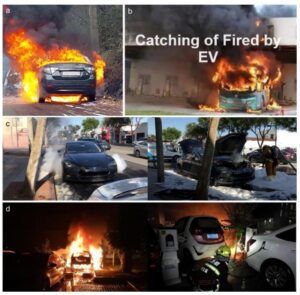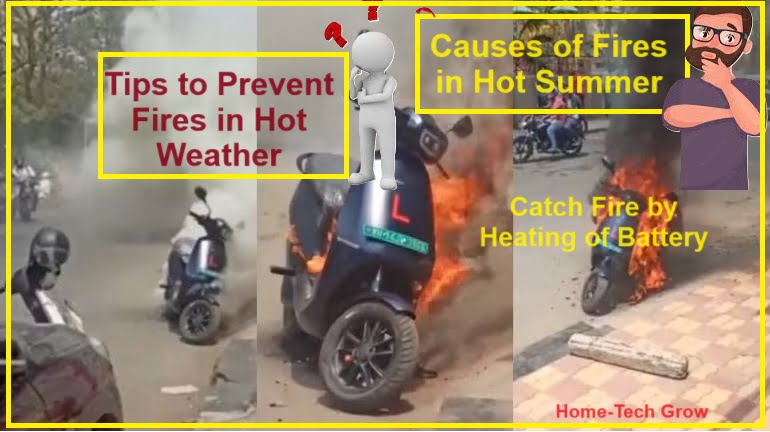- Fires in electric vehicle (EV) batteries, particularly in hot summers, can be caused by a combination of factors.
- Understanding these causes can help in taking preventative measures in electric vehicles.
- Fires caused by batteries in hot summers can be attributed to several factors, often related to the inherent properties of batteries and the environmental conditions.
- Here are some of the primary causes:
Overheating
- High Ambient Temperatures: In hot weather, the ambient temperature can cause the battery to overheat, especially if the bike is parked or stored in direct sunlight.
- Lack of Ventilation: Poor ventilation around the battery can lead to heat buildup, exacerbating the effects of high ambient temperatures.
Overcharging
- Faulty Chargers: Using chargers that are not compatible with the battery or have malfunctioning shut-off mechanisms can lead to overcharging, which generates excess heat.
- Prolonged Charging: Leaving the battery plugged in for too long can cause it to overcharge and overheat.
Thermal Runaway
- Chemical Reactions: High temperatures can accelerate chemical reactions inside the battery, leading to thermal runaway, where the battery generates heat faster than it can dissipate it.
- Internal Short Circuits: Manufacturing defects or physical damage to the battery can cause internal short circuits, leading to rapid heating and potential thermal runaway.
Mechanical Damage
- Physical Impact: Dropping the bike or exposing it to mechanical shocks can damage the battery cells, creating short circuits that lead to overheating and fires.
- Poor Handling: Mishandling the battery during maintenance or installation can cause physical damage.
Poor Quality Batteries
- Counterfeit Products: Using low-quality or counterfeit batteries increases the risk of failures and fires due to substandard materials and manufacturing processes.
- Lack of Safety Features: Inferior batteries may lack essential safety features such as thermal cutoffs and pressure relief vents.
Environmental Factors
- Exposure to Sunlight: Prolonged exposure to direct sunlight can raise the temperature of the battery beyond safe operating limits.
- Heat Accumulation: Parking or storing the bike in confined spaces with poor airflow can cause heat to accumulate around the battery.
Electrical Issues
- Faulty Wiring: Poor wiring connections can create resistance, generating heat and potentially leading to fires.
- Electrical Short Circuits: Defects in the bike’s electrical system can cause short circuits, which can overheat the battery.
Overloading
- Exceeding Load Capacity: Overloading the bike with weight beyond its designed capacity can strain the battery and electrical system, generating excess heat.
- High-Power Demands: Continuous high-speed riding or using power-hungry accessories can increase the load on the battery, causing it to overheat.



